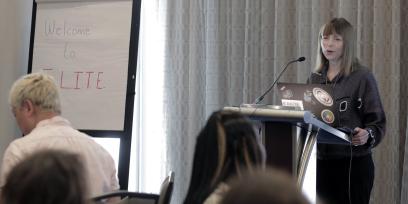Nearly all students experienced learning and achievement gaps because of the COVID-19 pandemic, but some of the most impacted were English language learners (ELLs). How can educators help these students get back on track and better support their language and literacy development?
This was the focus of the opening day TEACH workshop “Expanding Literacy Instruction by Tutoring English Learners: Project ELITE,” which presented the research and tools behind the AFT’s professional development course of the same name on supporting ELL language and literacy development. Based on a research project conducted to help ELLs master core academic content, the ELITE course is designed for educators or tutors working one-on-one or in small groups with students in grades K-5 who need additional literacy supports.
Workshop leaders Diane August, a co-principal investigator at the Center for the Success of English Learners, and Bethzaida “Betsy” Sotomayor, an AFT national trainer and member of the Volusia United Educators in Florida, shared how the ELITE model helps educators
- Compile student information to guide teaching;
- Select standards to guide lessons and set objectives;
- Use age-appropriate visuals and linguistic supports to scaffold content instruction that accounts for students’ varied first- and second-language proficiency;
- Provide vocabulary instruction that fosters students’ awareness and interest in words and helps them develop independent word-learning strategies;
- Use multiple strategies to support reading for understanding (including supplemental questions, guided discussions, sentence frames and stems, word banks and others);
- Build relevant background knowledge to support comprehension of essential information in anchor texts; and
- Incorporate writing to enhance language development and text comprehension.
Materials developed for the course are standards-based and include clear instructor guides and prompts so educators can use these materials directly in their classrooms. While the texts and methods are designed to target students in grades K-5, they are easily adapted for K-12 instruction. Throughout the session, presenters shared additional resources to help educators plan lessons, select and teach academic vocabulary, and scaffold instruction with visual and linguistic supports.
“Too often, teachers are not given the resources to design instruction that supports students in the ways they need, and we understand how challenging that is,” said August. “That’s why we developed these materials for instruction in a format that research shows is among the most effective interventions for student learning.”
Presenters modeled comprehension strategies such as designing guiding and follow-up questions and scaffolding student responses, then attendees worked together in small groups to practice the strategies in real time. At the end of the workshop, presenters assured attendees that more support is available from the AFT for those who wanted a deeper dive into the method.
“We’re giving you a lot of tools, but you don’t have to digest all this information at once,” said Sotomayor, who has piloted the ELITE model in her classroom. “Just take one or two ideas, see how they work for you, and then slowly add others and perfect each one in your classroom. With ELITE, you’ll quickly see that your ELLs will feel empowered and confident in their learning.”
[Lesley Gonzalez]

